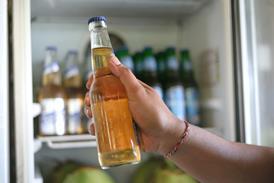Innovation, led by brands, helped fuel growth and drive chocolate sticks and bars and premium ice cream. Multipacks and tubs were also successful tools to maximise sales, and much of 2002's repertoire are geared towards them.
Rivals hoping to make huge gains in the freezer cabinet may have been disappointed. Birds Eye Wall's out-of-home category manager Barry Griffiths admits the company was hit and says its share of wrapped impulse at 65.7% was down 2.9% due to the scrapping of exclusivity [ACNielsen]. "But it wasn't as big a decline as predicted," he adds.
Manufacturers have been ruthless with their ranges. BEW has culled slow sellers, improved lines such as Cornetto Whippy and Solero Shots, and brought in products using the best ideas from snacking categories.
Richmond Frozen Foods has cut 20% of the Richmond/Nestlé cabinet cloggers' and installed lines with better potential. A major casualty was Kit Kat Chunky another in a long line of biscuit based products to fail. However, marketing director Kate Needham says there are other brands in the confectionery portfolio it may look at.
Masterfoods has axed four lines, and is recommending just 12 lines to maximise impulse sales, sticking to its high profile confectionery branded tubs and just one new line Maltesers ice cream stick, a lighter eat for women. "We need to ensure products are relevant and offer something not out there," says marketing manager Patrick Kalotis. "If the Maltesers stick takes off, why not then a tub in different sizes?"
RFF claims it increased its value share in impulse following its recent acquisition of Nestlé's ice cream. "FMD and a poor start to the summer contributed to a 4.8% decline in impulse but it was a vast improvement on the 18% fall in 2000," says Needham. "Even after our purchase of Nestlé ice cream, we grew our value share in impulse to just over 24% last year but, with multiple outlets now taking an estimated 4.7% value share, we can expect to see further encroachments on impulse this year. Retailers need to review their freezer space and make it work harder.
"Our aim is to be the UK's most cost effective ice cream manufacturer. We now have a broad range and access to Nestlé's expertise across Europe which we can tap into."
RFF has already invested £4.2m in improving Nestlé brands to strengthen its kids offering. Its core range will be: Smartie's Pop-up, Ribena Ice, FAB and Rowntree's Fruit Pastil lolly. It also has a Monsters Inc lolly, a Willy Wonka sour ice lolly and Munch Bunch fromage frais ice cream lollies, and is expanding its Treats value-for-money lolly range.
BEW aims to compete in the children's sector with Chupster, a combination of ice cream and a surprise Chupa Chups lolly.
Soft ice cream is a trend that started with the launch of McDonald's McFlurry in 1999. BEW's Griffiths says people like soft ice cream and McDonald's made it more available. Its aim to bring a McFlurry style product into the home has resulted in the Wall's Whipster.
Frederick's Dairies marketing director Peter Elvin says McDonald's was a threat. "Many people went to McDonald's just to eat McFlurry. It is aimed at teenagers and the big brands hadn't come up with anything like it for young adults," says Elvin.
"Individually wrapped lines out of newsagents and corner shops have declined, as youngsters' discretionary income is being mopped up by mobile phone cards and other things."
He says everyone needs to create new products, new routes to market and think about how to get ice cream into places where people spend their leisure time, such as in shopping malls.
In spite of impulse as a whole declining, he says Frederick's has doubled its impulse business thanks to forecourts where most shops stocked Cadbury's. Its biggest sellers were Cadbury's 99 Flake and Cadbury's Dairy Milk ice creams. This year it has high hopes for Dream and strawberry flavoured Cadbury's 99.
However, Frederick's is still more dominant in take home. Its ice cream is worth around £40m and Elvin says 75% of that is take home.
The company says Cadbury's Flake grew 47% last year because of high repeat purchase levels. "We had 35% of purchasers buying it every four weeks which is particularly good as ice cream is a low loyalty product," says Elvin.
The big challenge for Cadbury, he says, is to get more consumers exposed to the ice cream brand. A lot of sampling is planned such as road shows and Virgin concerts. "We have 100 summer events confirmed where both Cadbury's ice cream and chocolate will be attending."
BEW's research showed that at home consumers wanted small products and a wide choice of flavours in affordable packs so, taking cues from confectionery, it launched Magnum Moments 18 bite-size chocolate coated ice creams. It also found its niche in miniaturising already successful lines such as Cornetto Miniatures.
Another idea is a pick n' mix format. It trialled this in Tesco last summer and is following it up in 2002 with an offering of five from a choice of seven ice creams in a bag. Taking cues from the soaring smoothie sector, it has launched mango and passion fruit flavoured Solero Smoover in a pouch.
In the super premium arena, Häagen-Dazs has launched Minissime, a five pack of 45ml mini sticks consisting of chocolate and macadamia nuts coated vanilla ice cream, and chocolate and chocolate cookie coated chocolate ice cream.
Senior brand manager Reemah Sakaan says: "We are looking for new occasions and need states. We've already filled the gap for snacking with our mini cups in a multipack format and we've just launched a second mini cup format, Minissime, to complement that."
It is working with retailers to make the fixture a better place to shop and work, such as introducing spring-loaded shelves which propel products forward to eye level.
Ben & Jerry's has been left to its own devices by Unilever Bestfoods on the premise that if it ain't broke, don't fix it. Although predominant in 500ml tubs, it has made gains in 100ml which it claims grew 27% in 2001. Every year it introduces two flavours and this year's variants are Honey I'm Home, comprising honey vanilla ice cream and chunks of fudge covered honeycombe, and One Sweet Whirled, a mix of caramel and coffee ice cream with caramel and marshmallow swirls and coffe flavoured chocolate chunks.
Helping to promote its quirky image is its wacky web site. In 2001 this received 1.1 million hits and it now has 25,000 members of its Cool Club targeting 18- to 35-year-olds which it hopes to double this year.
Other companies in the super premium sector are last year's newcomer, Yeo Valley Organic, and Hill Station.
Yeo Valley Organic hopes to replicate in ice cream its success in organic yogurts. In January it launched a four-pack of 100ml tubs and recently a trio of super premium 500ml tubs in crème fraîche with blackcurrant, triple chocolate truffle, and orange and chocolate truffle flavours.
This year Hill Station gained its first national listing with Tesco. It now has 10 ice creams for grown ups, the latest being dark roast coffee made with freshly brewed espresso with a sprinkling of roasted ground coffee beans.
BEW heads the big spenders with £19m behind its brands. However, Masterfoods and Frederick's can rely on their confectionery might to provide extra support.
Cadbury's £27m on ambient products will help push ice cream. Launching Cadbury's Dream ice cream bar and Cadbury's Dream chocolate bar together was a first, and more cross selling and merchandising and even joint advertising are planned.
Its limited edition Cadbury's Crème Egg ice cream running alongside the chocolate Crème Egg was a coup for Frederick's. "This is added value marketing," says Elvin. "As time goes by we are upping our forecasts. We thought we'd sell between 1.5 and two million, but now we may sell three to four million."
All the major players have invested in scooping, a key driver for growth. RFF now has a range called Napoli via its acquisition of Allied Frozen Foods, Frederick's has developed a range it will be piloting and promoting, while Ben & Jerry's says scooping outlets make up 20% of its business.
According to BEW, scooping and desserts were up 25% in value last year [Information Resources]. Eighteen flavours of Carte d'Or are now being scooped from more than 2,000 cabinets. Its other ice cream stalwart, Viennetta, will get a boost this year to maximise its 20th birthday.
RFF is the leading own label manufacturer even though it now has a foothold in brands, and this year plans to launch 50 own label lines.
RFF's Needham says there is a definite trading up trend to dairy ice cream. "One litre and 500ml saw significant growth. For example in the year ending December 2001 own label retail sales of premium rose £3.8m while super premium 500ml lines increased 70% equivalent to a £19m increase."
It makes Asda's Really Creamy range which, it says, outsold Carte d'Or at Christmas, showing own label can compete successfully with brands such as Carte d'Or when they deliver superior quality and value for money.
{{FOCUS SPECIALS }}
Close menu
- Home
- Retail & Wholesale
-
Products & Suppliers
- Back to parent navigation item
- Products & Suppliers
-
Product Categories:
- Back to parent navigation item
- Product Categories:
- Alcoholic drinks
- Bakery
- Cereals & breakfast
- Cheese
- Chicken & poultry
- Chocolate
- Confectionery
- Crisps, nuts & snacks
- Dairy
- Fish
- Fresh produce
- Frozen
- Household
- Meat
- Own Label
- Sauces & condiments
- Seasonal
- Soft drinks
- Vaping
- Vegan & plant-based
- World foods
- Suppliers
- People
- Reports & Data
-
Topics A-Z
- Back to parent navigation item
- Topics A-Z
-
Popular topics:
- Back to parent navigation item
- Popular topics:
- Cost of living crisis
- Crime
- Deposit Return Schemes
- Finance
- Government & Regulation
- Health
- Inflation
- Loyalty
- Marketing
- Mergers & Acquisitions
- New Product Development
- Sourcing
- Supply chain
- Sustainability & environment
- Technology
- Ultra Processed Foods
- Vaping
- A-Z all topics
- Content by type:
- Events
- Ask iA (beta)
- Subscribe now
Sign in to comment on this article
Not logged in before? Register for FREE guest access today.
You will be able to:
- Read more stories
- Receive daily newsletters
- Comment on stories
Advert















No comments yet